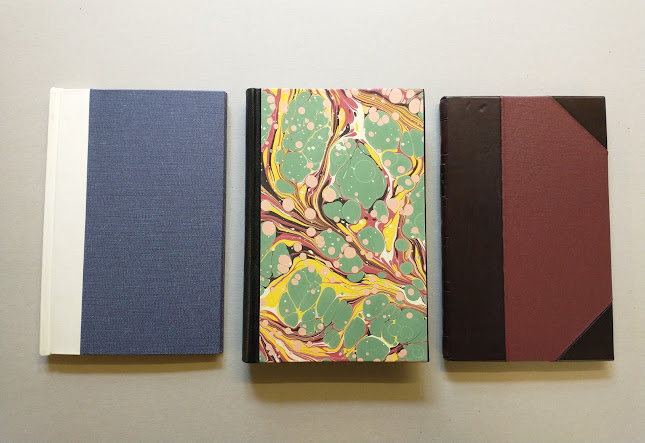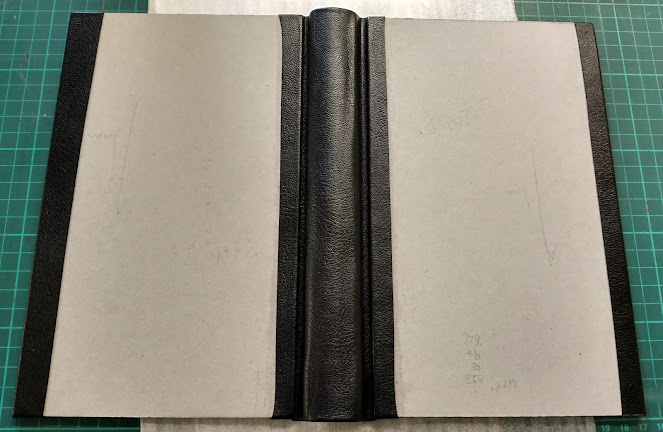Gebrochene Rücken: Peter D. Verheyen Edelpappband-Style Quenta Rebind
 |
A few years back I purchased a UNIVERSITY PRESS 4th impression of The Silmarillion (1977) purely for the purposes of bookbinding. I didn't intend to buy a 4th impression specifically, it's just what turned up in the post for £4.92 (inc. postage). Surprisingly—for that price—the dustjacket was present and in good condition, although the cloth-covered boards were suspiciously worn and sun-damaged in comparison. The binding was sound and the page-block relatively free from marks or damage. A suitable copy for the intended purpose, although almost in too nice a condition to pull apart. The bookbinder's dilemma.
This one copy of The Silmarillion has now
become three separate bookbinding projects. And with pp. 1–32 still unused, a
fourth project—a mock dummy book perhaps?—is still a possibility. For
this first project I was, for the most part, following the method(s) set out in the article ‘The Edelpappband, or
“Millimeter” Binding’ (The Bonefolder, Vol. 1.2, Spring 2005) by
Peter D. Verheyen.
QUENTA (b. 2022)
Because UNIVERSITY PRESS bound their copies of The Silmarillion in 32-page gatherings, the ‘Quenta Silmarillion’ falls nicely (complete) as gatherings 2–8. I decided to bind these on their own.
 |
| Exposed spine after lining removal |
My contemporary note for this binding reads:
“Rebind of several sections of larger orig.; gatherings (only) retained. Folios re-sewn using orig. punch holes; (made) endpapers, sewn on; sp. glued, rounded, backed (inc. sewn silk head/tail-bands), & lined; top-edge dyed. Bradel case made, with rounded sp. stiffener; leather sp., paper boards, fore-edge leather trim. Gold (foil) tooled sp. Matching marbled paper slipcase.”
It might be useful to unpack some of this.
The gatherings were separated and then re-sewn in order to incorporate sewing tapes; later these are used to attach the case. In most modern books—of the mass-produced variety—the case is usually only attached to the page-block by a narrow strip of the spine lining; as can be seen in the above image there are no tapes (or cords) in the original sewn structure. This makes for a very poor case attachment, a weak point in modern case-bound books.
 |
Spine re-sewn on 18 mm. sewing tapes |
‘Made’ endpapers are typically where a plain (white, cream, etc) piece of paper and a decorative or coloured paper are laminated together; as well as providing strength, this can also function to cover over the marked (on most) reverse side of hand-made decorative papers e.g. marbled paper. The endpapers were also sewn on, again, to provide more strength. I didn't use a decorative hand-made paper here, instead using a grey Ingres paper (made by HAHNEMÜHLE) with laid surface finish.
The
function of rounding the page-block is to prevent the spine (over time)
dropping into concavity and the fore-edge being pushed out into convexity; this
movement over time weakens the binding. The function of backing is principally
to create right-angled joints at the shoulders of the page-block; the book
boards sit against these. The joints support the boards and vice versa. Backing
also forces the spinefolds of each gathering over the adjacent gathering,
creating an angle (hook almost) so that each gathering effectively supports the next. All of
this further supports the page-block from dropping. There is an open debate in
bookbinding as to whether backing is truly necessary; historical examples of books that were rounded only seem to have held up well. I did round and back in this instance.
Sewn endbands and solid edge treatments are functional up to a point; endbands provide some support to the head and tail of the spine, but do certainly prevent material getting into the hollow; solid edge treatments stop dust sitting on the page-block (primarily on the top-edge) which would, in turn, attract moisture. Regardless, I always take the opportunity to practise these techniques. They also look nice.
 |
|
Top-edge dyed — sewn headband —
Bradel case
|
A Bradel binding is simply a type of German case-binding. It differs from a conventional case-binding in that the boards and spine stiffener are joined together by a piece of stiff paper before covering. It makes for a very sharp (tidy) finish to the case after covering; it is also quite a helpful starting technique for beginners.
 |
| Narrow leather strips to spine and fore-edges |
What defines this as a ‘millimetre’ binding is the use of small strips of (in this case) leather; the leather covers the spine with minimal encroachment onto the boards (enough to securely attach), and only covers (barely visible) the fore-edges of the boards. It is a technique that can be attempted with literally only scraps of leather to hand, previous project leftovers for example. This binding also has a very pronounced groove, which aids with book opening. The leather was worked on wet.
 |
| Paper covering and spine lettering complete |
Each letter on the spine was individually hand-tooled. I noted it as ‘foil’, but it is actually a kind of gold-leaf tape that I used, inherited from a retired bookbinder. The covering for the boards is a matter of personal choice; I used PAYHEMBURY hand-marbled paper, waxed and hand-burnished. The slipcase was unimaginatively matching. At this point I started making slipcases for most book projects.
 |
| Slipcase |
I think the end result is decent. Obviously, it has shelf appeal (the ‘finishing’), but I'm (still) pleased with it from a structural/functional perspective (the ‘forwarding’) too. I also got the opportunity to examine in more detail the structure of the UNIVERSITY PRESS 4th impression binding.
 |
This post is longer than I anticipated, so discussion of the AKALLABÊTH and INDEX projects will have to spill over into another later post(s). Three books and counting...
![[The] Silmarillion; book-collecting minutiae](https://blogger.googleusercontent.com/img/a/AVvXsEi7NXZeS-e6C3roxz2c7UWFEcUEINpMfgDkihMCeoVgjBGA-K9_wE7HmJ0J5LSIJqNm8fDVUqJ5HOvdvgIHgPctu9xPEx_CjPUqrXJEyd5Q-ftA4tlo6NhRx3V9JZl-IBbGvIvBQVjE9GFyKMqd_JrWwkLEqMMbhG2m3Q3FQuyhnjhlhdpebGxovD9adS1H=s456)


.jpeg)
Comments
Post a Comment